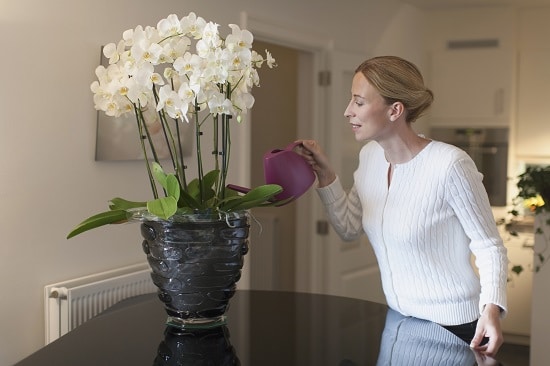With these Orchid Care Tips, you can grow the healthiest orchid indoors and enjoy the beautiful and delicate flowers in all their glory!
Orchid is an attractive, commonly grown, colorful and fragrant houseplant, popular across the world for its elegance and variety. It has the largest family of plants in the whole world, with 25000-30000 different species. Orchids are exceptionally adaptable and can grow in every condition. This quality makes them a perfect choice for a houseplant. Let’s have a closer look at the Orchid Care Tips!
Check out our article on peace lily growing tips here!
Requirements for Growing Orchids

Location
Choose a bright spot to locate orchids, as this plant thrives in indirect sunlight. East-facing windows work best for growing orchids. Try not to place your plant on the north-facing window since it can be too dark. Also, use a screen or a curtain to scatter the direct sun if you are keeping the plant near a south-facing window, as too much light can harm the plant.
Tip: If you don’t have an indoor location with bright indirect light, then place your orchids under grow lights.
To know more about grow lights panels for plants, click here!
Watering

Orchids are more drought-tolerant compared to plants that love moisture. Watering once a week is enough. Keep in mind that overwatering is the death of orchids because they don’t like to sit in the water-logged pot. This is one of the most important orchid care tips you have to follow.
Tip: Pseudobulbs (Thick part of a stem at base) are storage organs in orchids that save water and nutrients. Separating individual pseudobulbs can cause weak and slow growth in orchids. Never do this!
Check out our article on watering houseplants here!
Humidity
Orchids love humid conditions and proper airflow around the roots. So, if you live in a region with dry winter, place the pot on a tray of wet pebbles. You can also put a humidifier nearby the orchid plant, the best way to increase humidity. This is one of the most important orchid care tips you have to follow.
To learn how to increase humidity for indoor plants, click here!
Temperature
Orchids prefer a warm climate. A daytime temperature of 70-80 F (21-26 C) is ideal for optimum growth of the plant following with a nighttime temperature of 60-65 F (15-18 C). Though temperature below 55 F (12 C) can hurt the plant’s health.
Soil
You can experiment and try different types of DIY orchid mixes to see which one suits your orchid best, use ingredients such as charcoal, cork, sand, rock wool, and coconut husk chips. These types of mediums provide the plant quick drainage and turbulent airflow that orchid roots require. This is one of the most important orchid care tips you have to follow.
Orchids don’t need soil to grow, either you can buy a commercial orchid potting mix or make homemade one by mixing peat moss, fir bark, perlite (take two parts bark and 1 part peat moss).
Fertilizer
As a general rule, you can fertilize orchids once a month, though experts recommend a weekly feed. They recommend to nourish orchids with a weak solution of balanced liquid fertilizer weekly, use a fertilizer that contains equal parts of nitrogen, phosphorus, and potassium like (10-10-10) in a half or one-quarter strength, diluting it with water. This is one of the most important orchid care tips you have to follow.
There are also special fertilizers for orchids in the market which you can use. Do read the instructions on the label carefully before using it.
If you live in a cold climate, stop fertilizing during the dormant period in winter. Feed the orchids again in the coming spring season.
Tip: Don’t overfeed your orchids as it can result in quick but weak growth.
Points to Remember

- Crown Rot can occur if you water orchids from above. It is caused because of the standing water in the crown and between the leaves. Wipe off the water gently using a napkin.
- Some of the orchids produce aerial roots. These roots are visible and appear to have grown in the air. Do not cut these roots! It is normal for some orchids like Phalaenopsis. This is one of the most important orchid care tips you have to follow.
- Pests such as scale, aphids, or mealybugs can cause damage to orchids. The best way to get rid of them is by removing them manually. You can also use insecticidal soap. If that doesn’t work, chemical pesticides should be the last option.
- Most of the orchids bloom yearly. If you are going to maintain them well, they may blossom often — most of the varieties flower for 6-10 weeks.



My orchid hasn’t bloomed but I seem to be getting 2 leaves on the stem. What is this and what do I do with it?